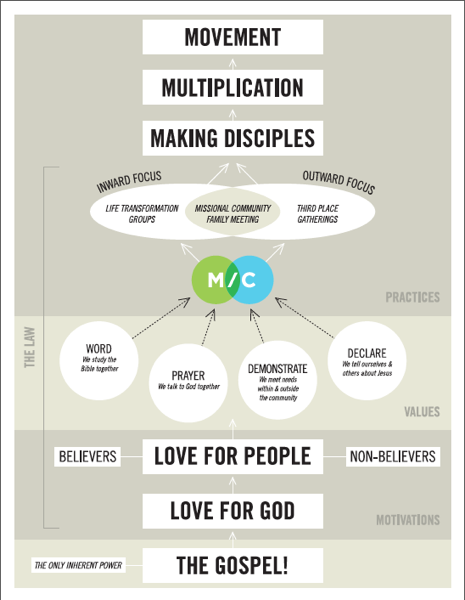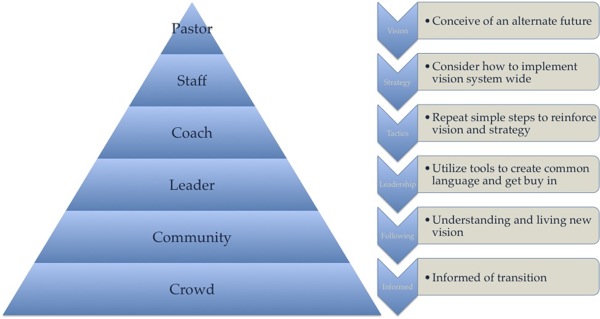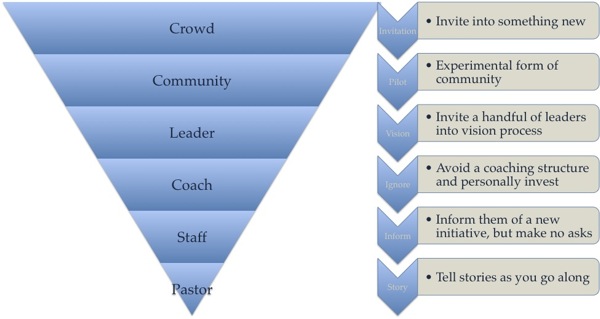The Austin Stone didn’t begin as a church committed to missional communities. Through several years, we have transitioned our church from a traditional community/small group model to our current model of missional communities. This series of posts will help you understand how we made that transition over time:
- Transitioning Your Church to Missional Communities
- Two Ways to Transition
- Creating a Sense of Urgency
- Forming a Strategic Team
- Crafting a Vision
- Communicating the Vision
- Empowering Others to Act
- Celebrating Wins
- Building on the Change
- Institutionalizing the Change
Much of this framework is adapted from John Kotter’s model for leading organizational change. I pray this series will help many of you that are leading churches through a season of transition!
—–
Create a Vision for the Preferred Future
After you’ve created a sense of urgency, and while you’re rallying a team, you need to be crafting a vision for missional communities in the life of your local church. Specifically, there are three areas that you need to focus on:
- Answering the question “why?”
- Providing a theological, philosophical and practical foundation for a missional community
- Crafting a short narrative for the vision
Answering “Why?”
When you first start thinking about change with your leadership team, there will probably be many great ideas and solutions floating around. I’m the kind of guy that wants to move immediately into problem-solving and execution mode. I crave action!
Before you move into execution though, you need to spend time crafting a vision, and specifically answering the question “why are we transitioning?” This is often tied to the same threads you utilized to create a sense of urgency and the need for change.
The answer to that question needs to be something that resonates with your general population of people, rather than just a group of bought in leaders. While every Christian in your church should care that there are lots of people who haven’t heard the gospel, for most of them statistics on the lostness of a city aren’t terribly compelling. Why should a person who has served faithfully in your children’s ministry for years care about the shift you are making? What would resonate deeply with someone who has been marginally connected to your church? To be effective here, consider the things that your most often communicate from your pulpit that has resonated with your people and tie into this thread. If you have built your church on the foundation of being a safe place for the family, then a good “why?” would be “To become more like God’s family”. If you’ve built on a foundation of good Bible teaching, then a good “why?” would be “To do what the Bible says”.
At The Stone, we didn’t actually begin our transition by talking about missional communities at all. We by focusing on the question: “Why do churches die?” To this day, it remains one of our most popular sermon series, and was a watershed series for our church body.
Thoroughly Understanding Your Vision
At The Stone, we tend to build almost any vision for ministry through the grid of:
- Theology – what is true from Scripture?
- Philsophy – how do I apply what is true into this culture?
- Practice – what am I going to do based on my theology and philosophy?
We didn’t do this very well when we transitioned to missional communities, but over time our vision solidified into this grid. Over time we realized that missional community is a “what”…it’s a vehicle for living out the mission of God in the context of community. Missional community for us is a collection of practices that foster obedience to Jesus as a community.
Cultivating obedience to Jesus is a “how” or a philosophy. This is a guiding principle that informs what we do – we preach a certain way because we want people to obey Jesus. We have certain ministries that help us foster obedience to the Word in different ways. We want to help consumeristic, materialistic, individualistic people in our culture see what it means to follow Jesus, because the gospel changes everything.
The gospel changes everything is a “why”. Jesus, who came to earth in the flesh, lived a perfect life, died an atoning death on the cross, and was resurrected from the dead is the fulcrum of human history. He changes everything – our identity, our community, our purpose, our affections, our ultimate destiny.
Linking your practice to a philosophy that is driven from a theology integrates multiple concepts to an overall vision that people can grasp over time. Practically speaking, this is what drove us to our Missional Community Roadmap:

Utilizing Narrative to Communicate Vision
The final thing you need to consider is answering the question “why transition?” is to make sure the answer captures the heart, not just the head. Facts are great for informing the mind, but stories are most effective at stirring the heart.
Answering the question with something like “we’re going to transition to missional communities because we’ll be much more effective in making disciples in our city” may be right, but it’s not something that people can really grab hold of. To build on the examples above, consider something like “our families are becoming like God’s family” or “we’re putting the Bible into action”. More important though, is communicating your vision through a story. Two great examples of how we have done this at The Austin Stone are our vision for 100 People and a few stories of missional community life (here, here and here).
Stories will powerfully communicate the vision for your transition, so find ways you can tell them compellingly!
Conclusion
A clear vision can help everyone understand why you’re asking them to do something. When people see for themselves what you’re trying to achieve, then the directives they’re given tend to make more sense. It isn’t just about having a catchy phrase and some branding, but having a fully-formed understanding of why you are making a transition and communicating it in a variety of different ways over time.
On a real practical note, here are some things you can do:
- Determine the values that are central to the change, and then answer the question “why?”
- Develop a short summary (one or two sentences) that captures what you “see” as the future of your church
- Ensure that your team can describe the vision in five minutes or less in their own words
- Create some visual aids and stories that you can use in different environments to facilitate communication

